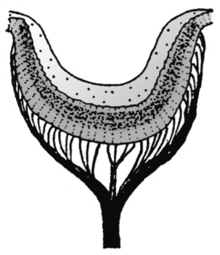Limpets
| Limpets | ||||||||||||
|---|---|---|---|---|---|---|---|---|---|---|---|---|

Limpets resting on a stone, the left one detached |
||||||||||||
| Systematics | ||||||||||||
|
||||||||||||
| Scientific name | ||||||||||||
| Patellidae | ||||||||||||
| Rafinesque , 1815 |
The limpets (Patellidae) are a family of marine snails . According to the classical system, they are included in the order of the adult snails (Archaeogastropoda).
features
The name refers to the appearance of the species in the family, because limpets do not have a spiral-shaped house with many windings like many other species of snail, but simply a bowl-shaped bowl , similar to the shell of the single shell , which is not, however, snails. It is difficult to distinguish between limpets, but they vary in color and in the shape and size of the shell. The apex of the bilaterally symmetrical houses is in the middle or slightly in front of it. The bowls are mainly sculptured radially from the tip to the edge. The inside of the bowls is either porcelain-like or shiny with mother-of-pearl . The muscle attachment to the snail shell is horseshoe-shaped, interrupted at the front. Depending on the species, the housing length of the adult animal varies between about 1 cm and 10 cm. The snails have no operculum .
The head has a strong snout and a pair of antennae, each with a small cup eye at the base . The big foot is very strong. The snails do not have real gills . Their function is taken over by numerous tentacle-like appendages that sit on the epipodium between the foot and the coat.
Some limpets are segregated, others hermaphrodites . The animals release their eggs and sperm into the open water and so external fertilization takes place. The fertilized eggs develop over a short trochophora stage into free-swimming Veliger larvae, which after a longer pelagic phase metamorphose into small snails .
In Spain they ( lapas ) are considered a delicacy.
Way of life
Limpets are perfectly adapted to life on rocks and hard ground. They do not have a lid, but with the help of acid excretions they can shape the stone so that it serves as a seat and closes the bowl-shaped housing perfectly towards the bottom. By means of a horseshoe-shaped shell muscle, the shell can be pressed so tightly against the stone that it can only be detached surprisingly before the snail has a chance to attach itself to the rock. The limpets therefore often live in the surf zone, where, due to their adaptations, neither the waves nor the rain or sun can harm them. However, they are not sessile , as one might believe, if they are always found in the same seat during the day. They usually crawl around at night, but find their way back to their place of residence on their own crawl, probably through chemical stimuli, but also through other sense organs. They graze on algae grass with their radula .
Systematics
- Patellidae Rafinesque-Schmaltz , 1815
-
Patella Linnaeus , 1758
- Transparent limpet ( Patina pellucida )
- Common limpet ( Patella vulgata ), occurs from the Lofoten to the Mediterranean.
- Blue limpet ( Patella coerulea ), is common in the Mediterranean
- Lusitan limpets ( Patella rustica ), in the Mediterranean and Atlantic to the Bay of Biscay
-
Cymbula
- Cymbula compressa (Linnaeus, 1758)
-
Patella Linnaeus , 1758
and numerous other genera.
literature
- K. Janke, B. Kremer: Dune, Beach and Wadden Sea , Kosmos-Verlag, 1999, ISBN 3-440-07734-9
Web links
- Fischhaus Zepkow: Family Patellidae - limpets
- Weichtiere.at: Limpets (Patellidae)
- Costello, MJ; Bouchet, P .; Boxshall, G .; Emblow, C .; Vanden Berghe, E. (2004). European Register of Marine Species ( start ): Patellidae Rafinesque, 1815
- Patellidae . From: JM Poutiers: Gastropods . In: Kent E. Carpenter, Volker H. Niem (eds.): FAO Species identification guide for fishery purposes. The living marine resources of the Western Central Pacific. Volume 1: Seaweeds, corals, bivalves and gastropods. Food and Agriculture Organization of the United Nations, Rome, 1998. pp. 394ff.
- ITIS report
- Animal Diversity Web
- Spanish video of limpets preparation


